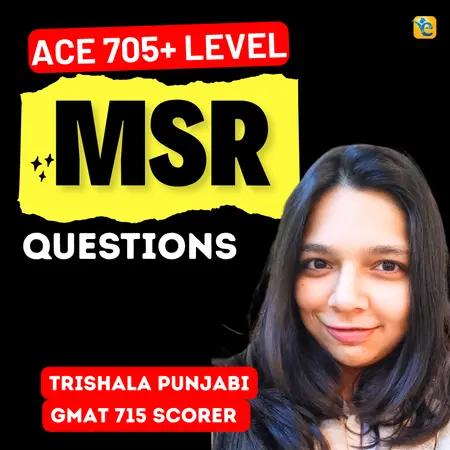Events & Promotions
|
|

GMAT Club Daily Prep
Thank you for using the timer - this advanced tool can estimate your performance and suggest more practice questions. We have subscribed you to Daily Prep Questions via email.
Customized
for You
Track
Your Progress
Practice
Pays
Not interested in getting valuable practice questions and articles delivered to your email? No problem, unsubscribe here.
- Nov 19
12:30 PM EST
-01:30 PM EST
Learn how Keshav, a Chartered Accountant, scored an impressive 705 on GMAT in just 30 days with GMATWhiz's expert guidance. In this video, he shares preparation tips and strategies that worked for him, including the mock, time management, and more - Nov 20
01:30 PM EST
-02:30 PM IST
Learn how Kamakshi achieved a GMAT 675 with an impressive 96th %ile in Data Insights. Discover the unique methods and exam strategies that helped her excel in DI along with other sections for a balanced and high score. - Nov 22
11:00 AM IST
-01:00 PM IST
Do RC/MSR passages scare you? e-GMAT is conducting a masterclass to help you learn – Learn effective reading strategies Tackle difficult RC & MSR with confidence Excel in timed test environment - Nov 23
11:00 AM IST
-01:00 PM IST
Attend this free GMAT Algebra Webinar and learn how to master the most challenging Inequalities and Absolute Value problems with ease. - Nov 24
07:00 PM PST
-08:00 PM PST
Full-length FE mock with insightful analytics, weakness diagnosis, and video explanations! - Nov 25
10:00 AM EST
-11:00 AM EST
Prefer video-based learning? The Target Test Prep OnDemand course is a one-of-a-kind video masterclass featuring 400 hours of lecture-style teaching by Scott Woodbury-Stewart, founder of Target Test Prep and one of the most accomplished GMAT instructors.
Originally posted by papillon86 on 08 Nov 2009, 14:11.
Last edited by Bunuel on 26 Oct 2017, 06:46, edited 3 times in total.
Last edited by Bunuel on 26 Oct 2017, 06:46, edited 3 times in total.
Edited the question and added the OA
Kudos
Bookmarks
C
Be sure to select an answer first to save it in the Error Log before revealing the correct answer (OA)!
Difficulty:
 55%
(hard)
55%
(hard)
Question Stats:
61% (01:56) correct 39%
(02:04)
wrong
39%
(02:04)
wrong  based on 1574
sessions
based on 1574
sessions
History
Date
Time
Result
Not Attempted Yet
In the x-y plane, the area of the region bounded by the graph of |x + y| + |x - y| = 4 is
A. 8
B. 12
C. 16
D. 20
E. 24
A. 8
B. 12
C. 16
D. 20
E. 24
Kudos
Bookmarks
papillon86
OK, there can be 4 cases:
|x+y| + |x-y| = 4
A. x+y+x-y = 4 --> x=2
B. x+y-x+y = 4 --> y=2
C. -x-y +x-y= 4 --> y=-2
D. -x-y-x+y=4 --> x=-2
The area bounded by 4 graphs x=2, x=-2, y=2, y=-2 will be square with the side of 4 so the area will be 4*4=16.
Attachment:
MSP17971c13h40gd024h6g10000466ge1e9df941i96.gif [ 1.86 KiB | Viewed 51789 times ]
Answer: C
Kudos
Bookmarks
srini123
I think this one is different.
\(|\frac{x}{2}| + |\frac{y}{2}| = 5\)
After solving you'll get equation of four lines:
\(y=-10-x\)
\(y=10+x\)
\(y=10-x\)
\(y=x-10\)
These four lines will also make a square, BUT in this case the diagonal will be 20 so the \(Area=\frac{20*20}{2}=200\). Or the \(Side= \sqrt{200}\), area=200.
If you draw these four lines you'll see that the figure (square) which is bounded by them is turned by 90 degrees and has a center at the origin. So the side will not be 20.
Also you made a mistake in solving equation. The red part is not correct. You should have the equations written above.
In our original question when we were solving the equation |x+y| + |x-y| = 4 each time x or y were cancelling out so we get equations of a type x=some value twice and y=some value twice. And these equations give the lines which are parallel to the Y or X axis respectively so the figure bounded by them is a "horizontal" square (in your question it's "diagonal" square).
Hope it's clear.














